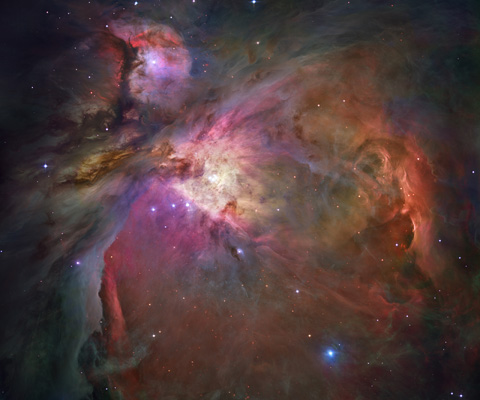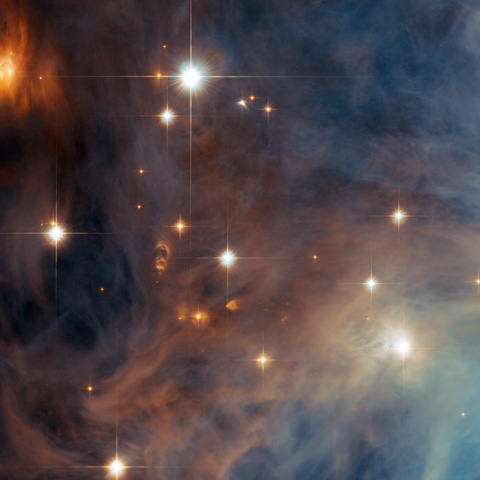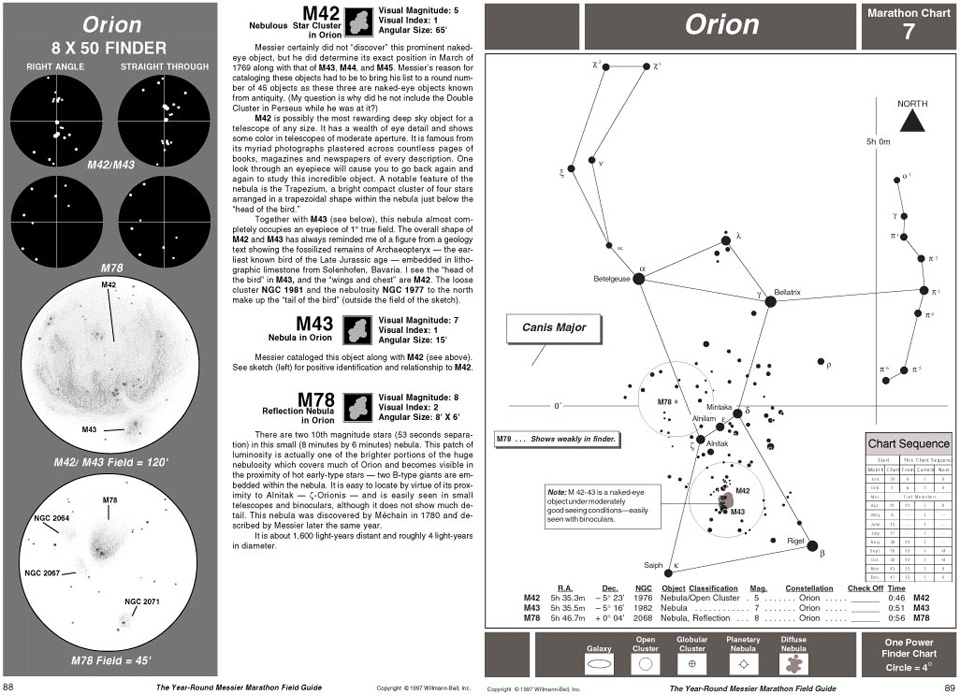Introduction
By no means complete, December’s mini guide that follows provides notes for exploring various interesting deep sky objects (DSOs) and lists other items of interest useful to the amateur astronomer.
Entries can be interpreted based on designation, description and magnitude as follows.
Designation – Description – Magnitude:
★ Telescopes 10-inch aperture minimum.
★★ Telescopes 6-inch to 9-inch aperture.
★★★ Binoculars (50mm+ aperture) and telescopes
3-inch to 5-inch aperture.
A collimated instrument, favourable atmospheric conditions, dark skies and dark-adapted eyes are assumed.

The M43 nebula. Image credit: NASA, ESA, M. Robberto
(Space Telescope Science Institute/ESA) and the
Hubble Space Telescope Orion Treasury Project Team.
About M43 nebula
This dramatic image offers a peek inside a cavern of roiling dust and gas where thousands of stars are forming. The image, taken by the Advanced Camera for Surveys (ACS) aboard NASA/ESA Hubble Space Telescope, represents the sharpest view ever taken of this region, called the Orion Nebula. More than 3,000 stars of various sizes appear in this image. Some of them have never been seen in visible light. These stars reside in a dramatic dust-and-gas landscape of plateaus, mountains, and valleys that are reminiscent of the Grand Canyon.
The Orion Nebula is a picture book of star formation, from the massive, young stars that are shaping the nebula to the pillars of dense gas that may be the homes of budding stars. The bright central region is the home of the four heftiest stars in the nebula. The stars are called the Trapezium because they are arranged in a trapezoid pattern. Ultraviolet light unleashed by these stars is carving a cavity in the nebula and disrupting the growth of hundreds of smaller stars. Located near the Trapezium stars are stars still young enough to have disks of material encircling them. These disks are called protoplanetary disks or "proplyds" and are too small to see clearly in this image. The disks are the building blocks of solar systems.
The bright glow at upper left is from M43, a small region being shaped by a massive, young star's ultraviolet light. Astronomers call the region a miniature Orion Nebula because only one star is sculpting the landscape. The Orion Nebula has four such stars. Next to M43 are dense, dark pillars of dust and gas that point toward the Trapezium. These pillars are resisting erosion from the Trapezium's intense ultraviolet light. The glowing region on the right reveals arcs and bubbles formed when stellar winds - streams of charged particles ejected from the Trapezium stars - collide with material.
The faint red stars near the bottom are the myriad brown dwarfs that Hubble spied for the first time in the nebula in visible light. Sometimes called "failed stars," brown dwarfs are cool objects that are too small to be ordinary stars because they cannot sustain nuclear fusion in their cores the way our Sun does. The dark red column, below, left, shows an illuminated edge of the cavity wall.
The Orion Nebula is 1,500 light-years away, the nearest star-forming region to Earth. Astronomers used 520 Hubble images, taken in five colours, to make this picture. They also added ground-based photos to fill out the nebula. The ACS mosaic covers approximately the apparent angular size of the full moon.
The Orion observations were taken between 2004 and 2005.
Image credit: NASA, ESA, M. Robberto (Space Telescope Science Institute/ESA) and the Hubble Space Telescope Orion Treasury Project Team.
Observation guide
| December deep sky objects |
| Auriga constellation |
|
NGC1907
|
Open cluster.
|
8.19
|
★★★
|
|
M36
|
Open cluster consisting of a dozen brighter stars against a background of fainter stars.
|
6.5
|
★★★
|
|
M37
|
An interesting open cluster with hundreds of stars of 8th-15th magnitudes. Fainter stars surround the central 9th magnitude red star near the centre adding to the cluster’s attraction.
|
6.0
|
★★★
|
|
M38
|
A 220 million years old open cluster. An interesting combination of bright and double stars, and dark lanes.
|
7.0
|
★★★
|
|
NGC1931
|
An open cluster between Auriga and M36. It appears as a nebulosity with a small number of stars embedded in it. Requires at least an 8 inches instrument to observe the cluster.
|
9.50
|
★★
|
|
NGC2192
|
A faint open cluster that requires a minimum 10 inches instrument observe.
|
10.9
|
★
|
|
NGC2126
|
Open cluster.
|
10.0
|
★★
|
|
NGC1893
|
Open cluster with over 60 stars.
|
7.5
|
★★
|
|
IC2149
|
Small planetary nebula with an 11th magnitude central star. The central star helps to locate the nebula which shows little detail even in large instruments.
|
11.2
|
★★
|
|
IC417
|
Diffuse nebula that is difficult to observe and will require large apertures and will benefit from filters.
|
14.5
|
★
|
|
IC405
|
Galaxy.
|
14.8
|
★
|
| Orion constellation |
|
M42
|
The Orion Nebula is visible to the unaided eye. It will show nebulosity in large binoculars and will take magnification very well. The Trapezium, a group of four stars, lies at the core and causes the nebula to emit light by heating the surrounding gas clouds.
|
5.0
|
★★★
|
|
M43
|
A bright emission nebula virtually part of the M42. It takes magnification well to reveal faint stars in the nebula and detail at its edges.
|
7.0
|
★★★
|
|
NGC1977
|
Low brightness diffuse nebula overpowered by 42 Orionis that requires a larger instrument to be seen. A mixture of emission and reflection nebulae it will appear red and blue respectively in photographs.
|
7.0
|
★★
|
|
NGC1973
|
A low brightness diffuse nebula with a strong blue colour only apparent in CCD images.
|
9.0
|
★
|
|
IC434
|
A thin diffuse nebula that requires very good conditions and apertures above 8 inches.
|
11.0
|
★
|
|
B33
|
The Horsehead Nebula is a dark nebula located just in front the IC434. It is very hard to discern and will require instruments of 16-inch apertures. A popular target for CCD cameras.
|
|
★
|
|
NGC2023
|
A diffuse nebula that appears as a gas cloud with an 8th magnitude star in its centre.
|
|
★
|
|
NGC2024
|
This emission nebula consists of two bright arcs separated by a dark rift. Visible in 8-inch instruments it will provide rewarding views in 10 and 12-inch aperture instruments.
|
10.7
|
★★
|
|
M78
|
A diffuse nebula located in the Orion’s Belt. CCD cameras will reveal an array of stars and an extended cloud structure.
|
8.0
|
★★
|
|
NGC1981
|
Open cluster in Orion with around 40 stars.
|
4.20
|
★★★
|
|
NGC1980
|
Open cluster with nebulosity and around 25 stars. A large aperture instrument is required to be able to observe the nebulosity.
|
|
★★
|
| Camelopardalis constellation |
|
NGC2523
|
Spiral galaxy at an angle that requires a large instrument to discern.
|
14.3
|
★
|
|
NGC2403
|
A bright galaxy viewable in large binoculars. Instruments above 8-inch aperture will reveal its structure.
|
8.9
|
★★
|
| Lepus constellation |
|
NGC2196
|
Larger instruments and CCD cameras will reveal the galaxy’s structure.
|
11.8
|
★
|
|
NGC1954
|
Large instruments and CCD cameras are required for this galaxy.
|
12.5
|
★
|
|
M79
|
Globular cluster that resembles a fuzzy star when viewed through binoculars.
|
8.5
|
★★★
|
|
|
Designation, Description, Magnitude
|
★ Telescopes 10-inch aperture minimum.
★★ Telescopes 6-inch to 9-inch aperture.
★★★ Binoculars (50mm+ aperture) and telescopes 3-inch to 5-inch aperture.
|
The night sky
Under excellent conditions over 2,000 stars can be seen with the unaided eye but only a few hundred of these are prominent enough to be useful in navigating the night sky, these are normally included in amateur sky maps and digital planetarium programs like the SkySafari, Stellarium, The Sky, Starry Night, Winstars 2 etc. Some stars will show colour that is useful in identifying them. For example, Antares, Betelgeuse and Aldebaran are orange/red where Vega, Rigel and Spica appear as blue/white.
Stars that form easily recognisable patterns have been given names and are referred to as constellations. Of these, the brightest stars act as beacons and can be used to effectively navigate the night sky during the different months of the year. To that extent stars can be particularly useful in locating other interesting objects nearby normally viewable through binoculars or larger instruments.
Planets and their satellites, comets and meteors move independent of the night sky background and at comparatively high speeds. They are therefore very difficult or impossible to reference to any star. However, planets like Jupiter, Saturn, Venus and Mars as well as the Moon are easy to spot with the unaided eye and in the case of the larger planets and especially the Moon, even medium size binoculars will reveal a limited degree of detail.
M43 nebula close-up view
The NASA/ESA Hubble Space Telescope has taken a close-up view of an outer part of the Orion Nebula’s little brother, Messier 43. This nebula, which is sometimes referred to as De Mairan’s Nebula after its discoverer, is separated from the famous Orion Nebula (Messier 42) by only a dark lane of dust.
Both nebulae are part of the massive stellar nursery called the Orion molecular cloud complex, which includes several other nebulae, such as the Horsehead Nebula (Barnard 33) and the Flame Nebula (NGC 2024).
The Orion molecular cloud complex is about 1400 light-years away, making it one of the closest massive star formation regions to Earth. Hubble has therefore studied this extraordinary region extensively over the past two decades, monitoring how stellar winds sculpt the clouds of gas, studying young stars and their surroundings and discovering many elusive objects, such as brown dwarf stars.
This view shows several of the brilliant hot young stars in this less-studied region and it also reveals many of the curious features around even younger stars that are still cocooned by dust.

The M43 nebula. Credit: ESA/Hubble & NASA.
This picture was created from images taken using the Wide Field Channel of Hubble’s Advanced Camera for Surveys. Images through yellow (F555W, coloured blue) and near-infrared (F814W, coloured red) filters were combined. The exposure times were 1000 s per filter and the field of view is about 3.3 arcminutes across.
Image credit: ESA/Hubble & NASA.
Sky conditions
The prevailing sky conditions will have a significant effect on what you can see through any instrument and binoculars. As such if you live near a city the light pollution can make it difficult to locate and observe most DSOs. The Moon and a hazy sky will also have a negative effect.
For best results observe from a dark site and under clear transparent skies without the moon being present. Once your eyes have been accustomed to the dark conditions (this takes around 20-30 minutes) you should be able to enjoy the night sky at its best.
Filters
Filters will help to an extent and lager instruments will benefit more from them. Light pollution filters would help and photo-visual UHC (nebula filters) would be worth considering.
Printed aids
A huge number of printed aids exist in terms of deep sky maps and books. An excellent printed guide for people new in astronomy is The Year-Round Messier Marathon Field Guide published by Willmann Bell Inc.
In this large format hard-back book, the author, Harvard Pennington shows how to:
- Learn 17 bright finder stars and 17 prominent finder constellations so you will know where to look for all 110 Messier objects.
- Align a sighting device such as an 8x50 finder scope or the Telrad® so that you can point your instrument rapidly and with assurance toward all of the Messier objects.
- Calibrate your instrument so that you know exactly how much sky you see through your finder and through the eyepiece of your instrument.
- Find all of the Messier objects using the maps, drawings and descriptions in this book. You will know exactly where to point your instrument, and what the object should look like when you find it.

Extract from The Year-Round Messier Marathon Field Guide
published by Willmann Bell Inc.
Related topics:
night sky, deep sky object guide, December



